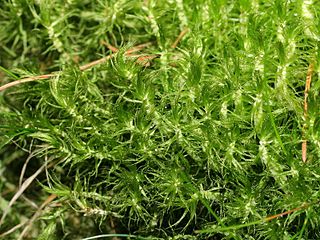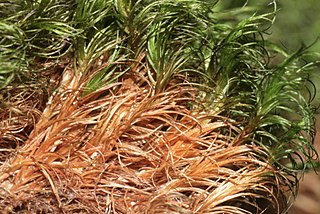
Funaria is a genus of approximately 210 species of moss. Funaria hygrometrica is the most common species. Funaria hygrometrica is called “cord moss” because of the twisted seta which is very hygroscopic and untwists when moist. The name is derived from the Latin word “funis”, meaning a rope. In funaria root like structures called Rhizoids are present.

Dicranum is a genus of mosses, also called wind-blown mosses or fork mosses. These mosses form in densely packed clumps. Stems may fork, but do not branch. In general, upright stems will be single but packed together. Dicranum is distributed globally. In North America these are commonly found in Jack pine or Red pine stands.

Hypnaceae is a large family of moss with broad worldwide occurrence in the class Bryopsida, subclass Bryidae and order Hypnales. Genera include Hypnum, Phyllodon, and Taxiphyllum.

Dicranaceae is a family of haplolepideous mosses (Dicranidae) in class Bryopsida. Species within this family are dioicous. Genera in this family include Dicranum, Dicranoloma, and Mitrobryum.

Grimmia is a genus of mosses (Bryophyta), originally named by Jakob Friedrich Ehrhart in honour of Johann Friedrich Carl Grimm, a physician and botanist from Gotha, Germany.

Pogonatum is a genus of mosses — commonly called spike moss — which contains approximately 70 species that cover a cosmopolitan distribution. It can be seen mostly in Asian countries with a tropical climate.

Grimmiaceae is a family of mosses in the order Grimmiales.

Schistidium is a plant genus in the moss family Grimmiaceae.

Cryphaea is a genus of mosses, (Bryophyta), containing at least 26 accepted species.

Campylopus is a genus of 180 species of haplolepideous mosses (Dicranidae) in the family Leucobryaceae. The name comes from the Greek campylos, meaning curved, and pous, meaning foot, referring to the setae which curve downwards.

Aulacomnium is a genus of mosses of the family Aulacomniaceae, with a circumpolar distribution.

Plagiomnium is a genus of mosses in the family Mniaceae. It was formerly a part of a more encompassing genus Mnium and in 1968 Finish bryologist Timo Juhani Koponen justified splitting the genus into a number of smaller genera.

Thuidium delicatulum, also known as the delicate fern moss or common fern moss, is a widespread species of moss in the family Thuidiaceae. It is found in North and South America from Alaska to Brazil.

Distichium is a genus of haplolepideous mosses (Dicranidae) in the monotypic family Distichiaceae.

Syntrichia is a large, cosmopolitan genus of mosses in the family Pottiaceae. The genus name is of Greek origin for "plus" and "hair", referring to the "twisted peristome united by a basal membrane".

Barbula unguiculata is a species of moss belonging to the family Pottiaceae.
Alleniella is a genus of mosses belonging to the family Neckeraceae.
Aloina is a genus of mosses belonging to the family Pottiaceae.















